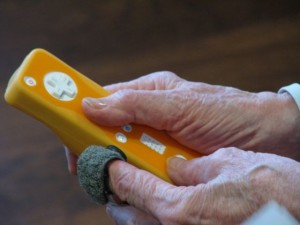Revealed: The likely role of Parkinson’s protein in the healthy brain
on April 30th, 2013 1 Comment
 So-called Lewy bodies - gumball-like clumps rich in a mystery molecule called alpha-synuclein - abound in Parkinson patients’ brains and are considered the hallmark of the disease. Up to now, researchers have had few solid clues as to what this “black hat” protein is doing in the brain in the first place.
So-called Lewy bodies - gumball-like clumps rich in a mystery molecule called alpha-synuclein - abound in Parkinson patients’ brains and are considered the hallmark of the disease. Up to now, researchers have had few solid clues as to what this “black hat” protein is doing in the brain in the first place.
But a team led by Stanford neuroscientists Tom Sudhof, MD, and Axel Brunger, PhD, has revealed a likely critical role played by alpha-synuclein in healthy brains. Their discovery is described in an article just published in the open-access online journal eLife.
Each of the human brain’s roughly 200 billion nerve cells communicates directly with, on average, 10,000 others by squirting signaling chemicals called neurotransmitters at them. It is all this squirting that underpins our thoughts, feelings and movements.
Of course, the brain’s activity is no mob squirt-gun shootout. Consider: The 2 quadrillion separate nerve-cell connections in your brain or mine roughly equal the number of stars in 7,000 Milky Way galaxies. For our most exalted organ to do its job, the signals that nerve cells send must be marked by profound precision, both in their intensity and in their timing.
As I wrote in my release accompanying the eLife article:
Nerve cells don’t simply squirt out neurotransmitters willy-nilly. Within the complex networks that constitute our brains, every individual nerve cell has a lengthy, snaking, tubular extension cord, or axon, that hooks up with thousands of other nerve cells. Neurotransmitters are housed within tiny bubble-like packets in the cell. These packets congregate in myriad small, bulbous nozzles dotting the axon, with each bulb abutting a downstream nerve cell. When an electrical impulse travels down the axon on which those bulbs reside, it triggers the fusion of the neurotransmitter-packed packets with the nerve cell’s outer membrane. The packets’ contents then spill into the narrow space separating the bulbs from the nerve cells they abut.
The Sudhof-and-Brunger team was able to show that alpha-synuclein helps regulate the orderly clustering of the neurotransmitter-loaded packets near their release sites. Alpha-synuclein has to be present in the right amounts, though; too much or too little has untoward consequences - which could explain why previous research has yielded conflicting results.
It’s nice to know, before messing around with it in living people, that in the healthy brain alpha-synuclein is a lot more than just a raw material in a gumball factory. Drug companies may have perhaps been led down some blind alleys as a result of locking in, too early, on the notion that yet another clump-generating protein, A-beta, was the Bad Guy in Alzheimer’s disease and that, it followed, getting rid of it would be a good idea. Maybe not so fast…
Previously: Nervous breakdown: Preventing demolition of faulty proteins counters neurodegeneration in lab mice, Stanford scientist sets sail on new publishing model with launch of open-access, embargo-free journal and Stanford study identifies molecular mechanism that triggers Parkinson’s
Photo by akeg









